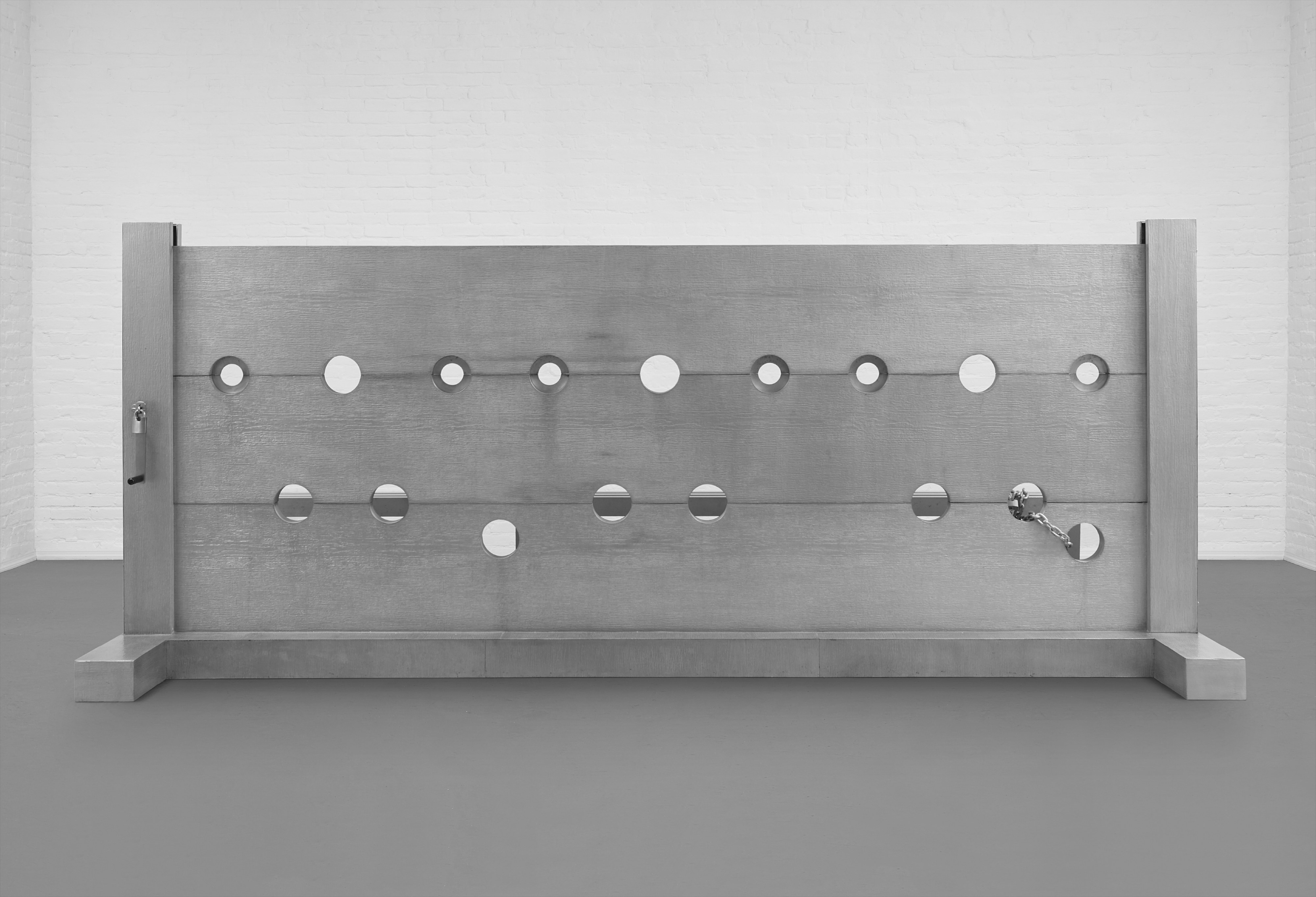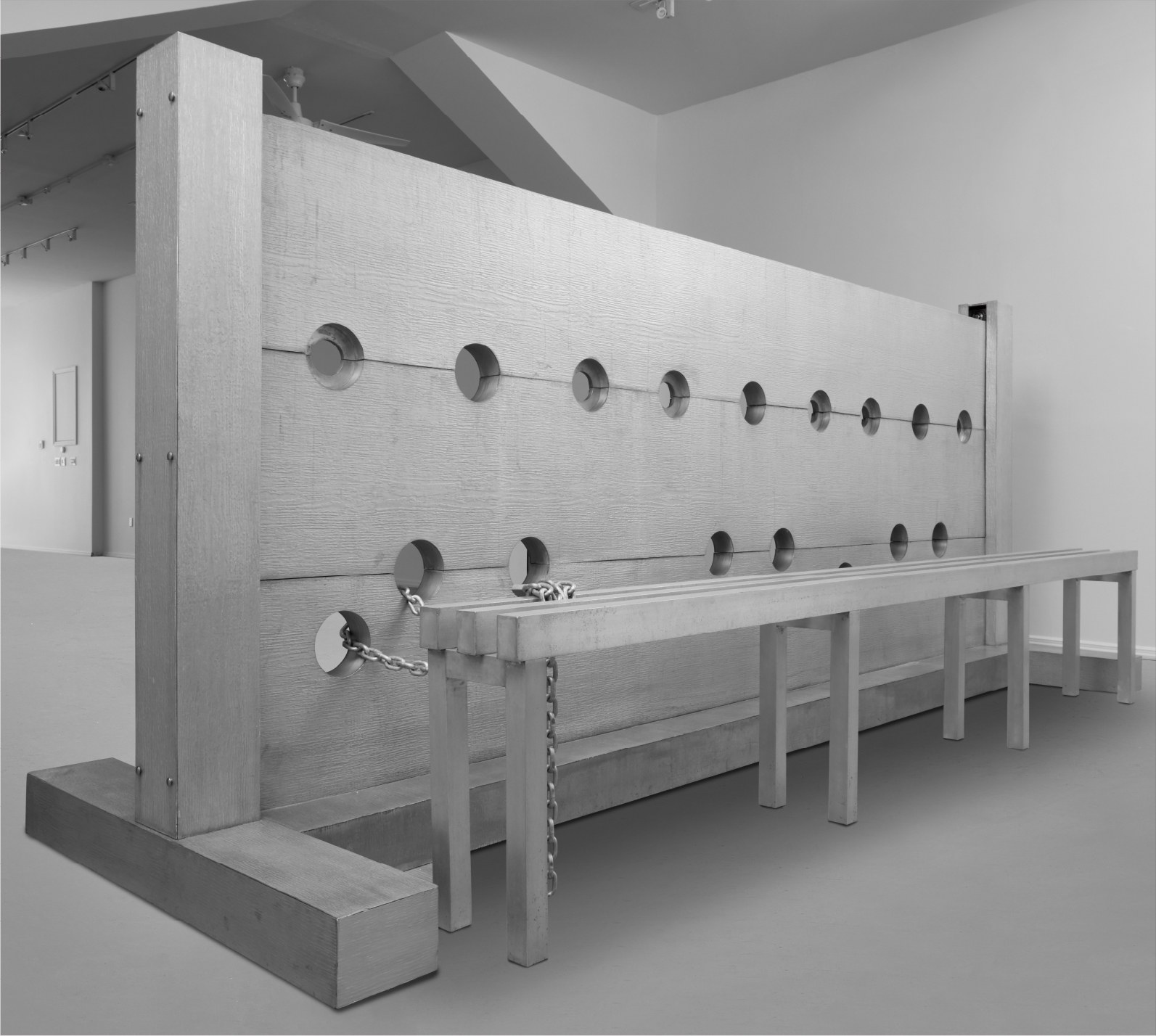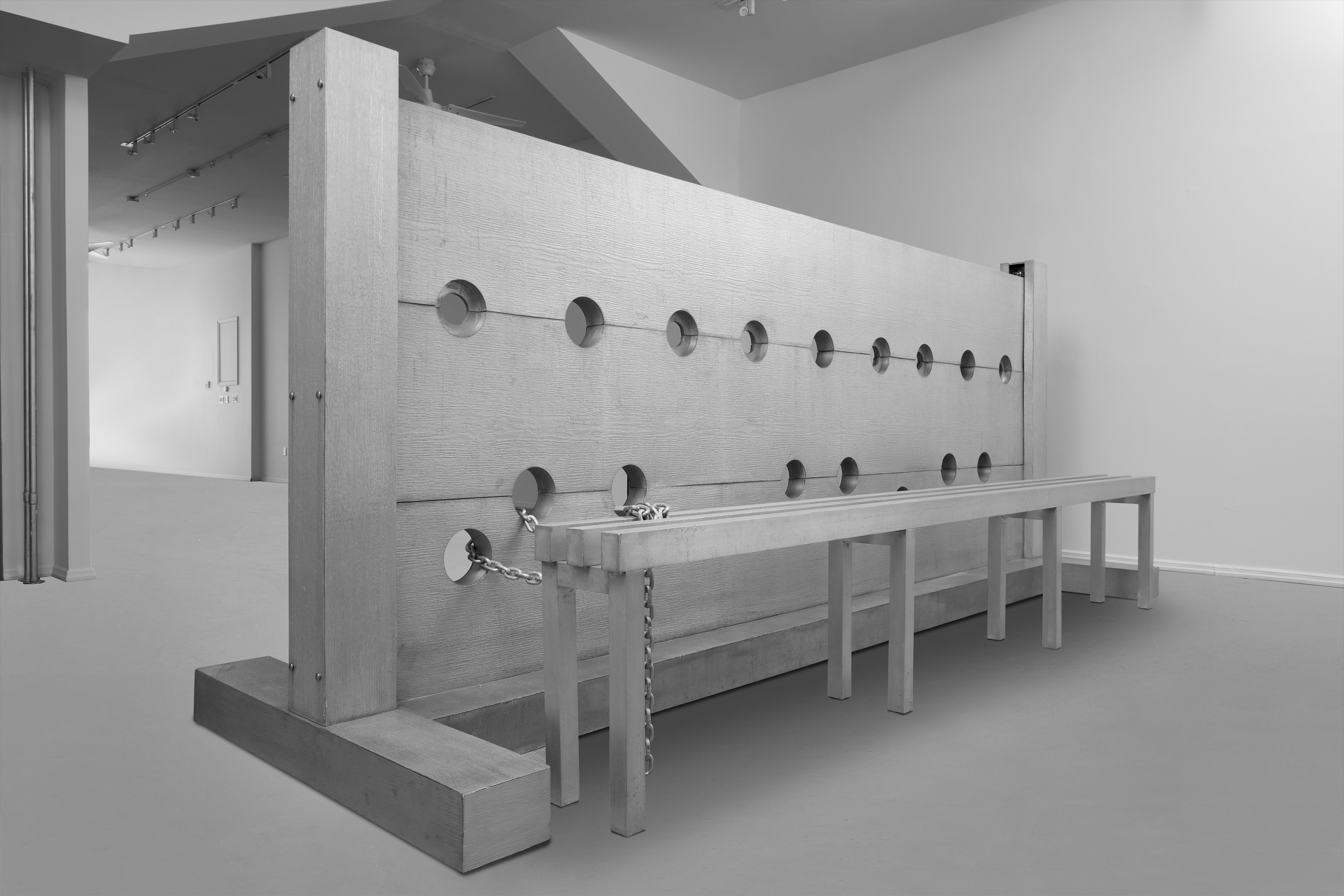











34
Cady Noland
Tower of Terror
cast aluminum stockade, bench, link chain, padlocks, key
stockade 65 5/8 x 158 1/8 x 50 in. (166.7 x 401.6 x 127 cm.)
bench 23 1/2 x 133 5/8 x 10 1/4 in. (59.7 x 339.4 x 26 cm.)
bench 23 1/2 x 133 5/8 x 10 1/4 in. (59.7 x 339.4 x 26 cm.)
Executed in 1993-1994, this work is accompanied by a certificate of authenticity signed by the artist.
We thank Cady Noland for reviewing the cataloging for this work.
We thank Cady Noland for reviewing the cataloging for this work.
Full-Cataloguing
“A good way to decipher my pieces is to look at how they ‘behave’.” – Cady Noland
Tower of Terror, 1993-1994, represents the central tenant of Cady Noland’s conceptual practice: the subversion of the American psyche through celebrity and violence. With a nod to Pop and Minimalism, Noland has created a monumental sculpture whose austere aesthetic belies the fact that it is, in fact, a fully-functioning multi-person stockade. Representing the pinnacle of the artist’s discrete series of stockades, Tower of Terror is the largest and only multi-person sculpture. The work was specifically conceived for the artist’s installation in Public Information: Desire, Disaster, Document, at the San Francisco Museum of Art that opened in January 1995. The exactitude and creative fervor with which Noland developed Tower of Terror is captured in no fewer than twenty studies which are now held in the permanent collection of the Museum of Modern Art, New York. Not seen in an institutional setting in nearly 25 years, Tower of Terror returns to take its place as an archetype of Noland’s ground-breaking and influential practice at a moment in our political landscape that exemplifies just how prescient Noland has been in her deadpan critique of American culture.
With Tower of Terror, Noland has created a modern vision of the stockade – the restraining device used by civil and military authorities from medieval to early modern times to put the individual on display for abject vilification and humiliation in the public space. Creating a modern vision of the stockade, Noland had Tower of Terror precisely engineered and fabricated from aluminum material that was given a faux wood-grain treatment and incised with enough holes to fit five persons. While at first glance, the work reads as an austere minimalist sculpture, the heavy iron chain linked around the lower right circular opening draws the viewer’s attention to what lies behind the crisp geometries. As one approaches the work, a padlock begins to register until, finally, one discovers the long bench that is chained to the stockade. Tower of Terror is the only known multi-person mechanical stockade that Noland had engineered, which not only facilitates the process of detention, but also results in a fascinating stand-alone kinetic effect when operated devoid of persons.
At once referencing the historical antecedent of the object itself as well as the aesthetic vocabulary of 1960s Minimalism, Noland not only disrupts traditional readings of material, but also evidences through a very formalist framework parallels to how humiliation can strip one of identity, drawing powerful allusions to her statement that “There is a method in my work which has taken a pathological trend. From the point at which I was making work out of objects I became interested in how, actually, under which circumstances people treat other people like objects” (Cady Noland, quoted in Michèle Cone, “Interview with Cady Noland”, Journal of Contemporary Art, vol. 3, no. 2, 1990, pp. 20-25).
A powerful motif, the stockade unites Noland’s formalist concerns with her distinctly sobering conceptual pursuits that saw her dubbed by art critic Peter Schjeldahl as the “dark poet of the national consciousness” (Peter Schjeldahl, “Venice Anyone?”, Mirabella, September 1990, p. 93). The artist considers the stockade the first public sculpture in colonial America. As James Rondeau and Andrea Miller-Keller noted, “For Noland, the stock directly references the ceremonial rituals of public humiliation and shape that occupied both moral and geographic center of civic life, prompting the theme of humiliation that resides in the American consciousness” (James Rondeau and Andrea Miller-Keller, Cady Noland / Matrix 130, exh. cat., The Wadsworth Atheneum Museum of Art, Hartford, 1996, p. 6). Noland foregrounds the perverse allure of this form of public entertainment through the interactive nature of the work. In Tower of Terror, Noland magnifies the fine line between public and private, by putting forward a device that could hold three people. The addition of the bench which extends the length of the stockade doubles as both reference to the detained and the spectacle aspect for the viewer.
Tower of Terror’s stark presence powerfully echoes those moments in contemporary culture when a private indiscretion becomes tabloid fodder for public consumption. And while her practice had singled out real-life examples of those riding the line between celebrity and notoriety, Charles Manson, Vince Foster, Betty Forde and Thomas Eagleton to name a few, in the absence of a vilified in her stockade, Noland allows a host of associations to proliferate, emphasizing her statement that she is “not especially interested in these particular people or events” (Cady Noland, quoted in conversation with John S. Weber, September 1994, Public Information: Desire, Disaster, Document, exh. cat., San Francisco Museum of Art, San Francisco, 1995, p. 159).
Fusing the functionality of the stockade with the formalism of minimalist sculpture, Tower of Terror forms an austere interpretation of American life and values. Nearly 25 years on, John S. Weber’s assessment at the time of Tower of Terror’s conception, still rings true: “This is not an optimistic view of life in these United States, but an accurate one. In the artist’s own words, ‘Ideally I would like to make work which, rather than appearing to master misplaced anxiety, mirrors the anxiety itself’” (John S. Weber, Public Information: Desire, Disaster, Document, exh. cat., San Francisco Museum of Art, San Francisco, 1995, p. 159).
Tower of Terror, 1993-1994, represents the central tenant of Cady Noland’s conceptual practice: the subversion of the American psyche through celebrity and violence. With a nod to Pop and Minimalism, Noland has created a monumental sculpture whose austere aesthetic belies the fact that it is, in fact, a fully-functioning multi-person stockade. Representing the pinnacle of the artist’s discrete series of stockades, Tower of Terror is the largest and only multi-person sculpture. The work was specifically conceived for the artist’s installation in Public Information: Desire, Disaster, Document, at the San Francisco Museum of Art that opened in January 1995. The exactitude and creative fervor with which Noland developed Tower of Terror is captured in no fewer than twenty studies which are now held in the permanent collection of the Museum of Modern Art, New York. Not seen in an institutional setting in nearly 25 years, Tower of Terror returns to take its place as an archetype of Noland’s ground-breaking and influential practice at a moment in our political landscape that exemplifies just how prescient Noland has been in her deadpan critique of American culture.
With Tower of Terror, Noland has created a modern vision of the stockade – the restraining device used by civil and military authorities from medieval to early modern times to put the individual on display for abject vilification and humiliation in the public space. Creating a modern vision of the stockade, Noland had Tower of Terror precisely engineered and fabricated from aluminum material that was given a faux wood-grain treatment and incised with enough holes to fit five persons. While at first glance, the work reads as an austere minimalist sculpture, the heavy iron chain linked around the lower right circular opening draws the viewer’s attention to what lies behind the crisp geometries. As one approaches the work, a padlock begins to register until, finally, one discovers the long bench that is chained to the stockade. Tower of Terror is the only known multi-person mechanical stockade that Noland had engineered, which not only facilitates the process of detention, but also results in a fascinating stand-alone kinetic effect when operated devoid of persons.
At once referencing the historical antecedent of the object itself as well as the aesthetic vocabulary of 1960s Minimalism, Noland not only disrupts traditional readings of material, but also evidences through a very formalist framework parallels to how humiliation can strip one of identity, drawing powerful allusions to her statement that “There is a method in my work which has taken a pathological trend. From the point at which I was making work out of objects I became interested in how, actually, under which circumstances people treat other people like objects” (Cady Noland, quoted in Michèle Cone, “Interview with Cady Noland”, Journal of Contemporary Art, vol. 3, no. 2, 1990, pp. 20-25).
A powerful motif, the stockade unites Noland’s formalist concerns with her distinctly sobering conceptual pursuits that saw her dubbed by art critic Peter Schjeldahl as the “dark poet of the national consciousness” (Peter Schjeldahl, “Venice Anyone?”, Mirabella, September 1990, p. 93). The artist considers the stockade the first public sculpture in colonial America. As James Rondeau and Andrea Miller-Keller noted, “For Noland, the stock directly references the ceremonial rituals of public humiliation and shape that occupied both moral and geographic center of civic life, prompting the theme of humiliation that resides in the American consciousness” (James Rondeau and Andrea Miller-Keller, Cady Noland / Matrix 130, exh. cat., The Wadsworth Atheneum Museum of Art, Hartford, 1996, p. 6). Noland foregrounds the perverse allure of this form of public entertainment through the interactive nature of the work. In Tower of Terror, Noland magnifies the fine line between public and private, by putting forward a device that could hold three people. The addition of the bench which extends the length of the stockade doubles as both reference to the detained and the spectacle aspect for the viewer.
Tower of Terror’s stark presence powerfully echoes those moments in contemporary culture when a private indiscretion becomes tabloid fodder for public consumption. And while her practice had singled out real-life examples of those riding the line between celebrity and notoriety, Charles Manson, Vince Foster, Betty Forde and Thomas Eagleton to name a few, in the absence of a vilified in her stockade, Noland allows a host of associations to proliferate, emphasizing her statement that she is “not especially interested in these particular people or events” (Cady Noland, quoted in conversation with John S. Weber, September 1994, Public Information: Desire, Disaster, Document, exh. cat., San Francisco Museum of Art, San Francisco, 1995, p. 159).
Fusing the functionality of the stockade with the formalism of minimalist sculpture, Tower of Terror forms an austere interpretation of American life and values. Nearly 25 years on, John S. Weber’s assessment at the time of Tower of Terror’s conception, still rings true: “This is not an optimistic view of life in these United States, but an accurate one. In the artist’s own words, ‘Ideally I would like to make work which, rather than appearing to master misplaced anxiety, mirrors the anxiety itself’” (John S. Weber, Public Information: Desire, Disaster, Document, exh. cat., San Francisco Museum of Art, San Francisco, 1995, p. 159).